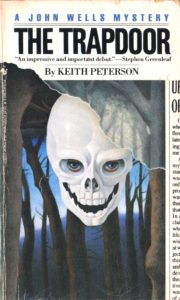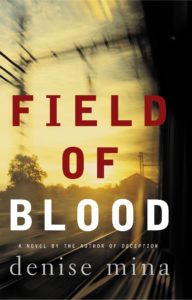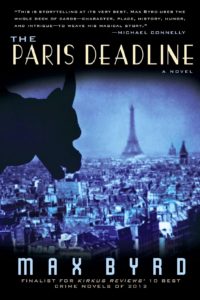Like so many other folks, I was inspired to become a journalist thanks to the example set by The Washington Post’s Bob Woodward and Carl Bernstein, whose determined investigation of Richard Nixon’s Watergate scandal in the early 1970s demonstrated the press’ ability to hold even powerful people accountable for their misconduct. Decades have passed since then, and I’ve seen the media occasionally fail to reward the public’s trust. But never once have I regretted my choice to go into journalism, no matter what toxic attacks have been leveled against the press by politicians (“the enemy of the American people,” cries Donald Trump) and others hoping to forestall criticism of their activities or substitute their own interpretation of events for what’s been scrupulously published.
The role of reporters as seekers of the truth has made them splendid substitutes for police detectives and private eyes in crime fiction. Scores of contributors to this genre (including modern authors Laura Lippman, Stieg Larsson, Julia Dahl, Wallace Stroby, Edna Buchanan, Michael Connelly, Kristi Belcamino, Brad Parks, and Rick Mofina) boast news-gathering backgrounds, so it’s understandable that crime and thriller fiction should be rife with journalists as determined as any shiny-badged cop or corners-cutting gumshoe to ferret out lawbreakers. I haven’t space enough to catalogue all the novels in which they appear, so I’ve restricted my list to a representative selection featuring newspaper reporters—“scribbler sleuths,” if you will.
Curtains for the Editor by Thomas Polsky (1939)
Polsky was evidently a onetime newspaperman from North Carolina, who penned three novels starring L.F. “Grid” Griddle, a persistent young reporter for the Citizen, serving an unnamed American Midwest town. The first of those, Curtains for the Editor, has Grid probing the demise of Charles Corey, his broadsheet’s dashing 53-year-old editor in chief, who made a business of crusading against local vice and municipal corruption…until he was found impaled by a spindle in his office. It’s Grid who finds the body along with Corey’s friend, John Meriwether, an elderly, broken former editor (everyone calls him “Pop”) who has been reduced to the role of daily columnist. While Pop’s insights prove valuable, Grid’s the clever one, questioning why there were two bottles of hot coffee in Corey’s sanctum, when he’d ordered only one sent up, and what relevance there might be to a glass sliver left on the ledge outside that office. Presumptions of this homicide being payback for Corey’s pursuit of mobsters and their political collaborators are amplified by a posthumous letter from the editor, declaring “I have been murdered.” Yet the possibility that Corey’s womanizing, especially his fondness for his son’s wife, led to his death can’t easily be dismissed. This is a classic newspaper yarn, with a soundtrack of typewriters clacking and shouts for “copy boys.” Polsky’s other L.F. Griddle novels are Curtains for a Judge (1939) and Curtains for a Copper (1941).
Focus on Murder by George Harmon Coxe (1954)
After cutting his fiction-writing teeth at Black Mask magazine, with many of his short stories headlined by hard-boiled crime shutterbug Jack “Flashgun” Casey, Coxe authored Murder with Pictures (1935), his first novel starring a relatively more refined photojournalist, Kent Murdock of the Boston Courier-Herald. Focus on Murder, the 15th Murdock outing, sends our dapper snapper out with Ralph Stacy, a reporter who “works some with a camera,” on what should’ve been a routine assignment…but turns out to be quite something else again. Dropping by Stacy’s apartment, the pair are shot at from a passing automobile. Then, after Stacy excuses himself briefly from the premises, Murdock is accosted there by a winsome brunette waving a gun and demanding a picture Stacy had taken of her brother. She’s followed closely in the door by an obviously wealthy woman, clutching a mysterious envelope. And not long after Murdock leaves that second visitor behind in the flat, he learns Stacy is dead, riddled with six bullets. Who ventilated the lensman? Could it have been one of the poor saps Stacy had been blackmailing? Murdock’s an observant fellow by inclination as well as profession, and that skill proves beneficial when he sets off to expose his colleague’s killer.
Night Extra by William P. McGivern (1957)
McGivern wrote more than two dozen novels, several of them adapted for the silver screen, and scripted classic TV crime dramas such as Adam-12 and Kojak. Yet he’s all but forgotten nowadays—which is too bad, because this guy could really deliver exhilarating fiction. Case in point: Night Extra, a hard-driving story about political grifters, toppled idols, and the Fourth Estate’s ability to render some version of justice even in the face of daunting odds. Lawyer-turned-reformer Richard Caldwell looks to be making significant headway in his campaign against Shaw Ticknor, a coarse sham populist, “compulsive lecher,” and the mayor of an unidentified, insidiously corrupted East Coast burg. At least that’s true until word spreads that the challenger has been shacking up with singer/model Eden Myles, the too-close friend of a pocket-edition hood. When, shortly thereafter, Eden is found strangled beside a drunken Caldwell in his home, the coming election’s outcome seems all but decided. However, Sam Terrell, a shrewd Call-Bulletin columnist, suspects Caldwell was framed in order to ensure the continued dominance of his town’s political machine. His challenge is to convince witnesses to come forward with information—even if doing so puts their life in jeopardy. McGivern was a onetime police reporter, and his savvy about newsrooms and criminal practices shines through on every page.
Conflict of Interest by Les Whitten (1976)
One of numerous hero-journalist novels released in the wake of Watergate, Conflict of Interest—composed by a longtime Washington, D.C., newshawk—focuses on Aubrey Warder, a middle-aged reporter for the Washington Eagle, whose stories about how federal officials “dipped in the till or otherwise screwed the country” have won him few friends among his paper’s national staff, but earned him a solid rep for muckraking. No matter that—at risk to his weak heart—he sometimes employs sex to wring information from well-placed female sources. Warder has lately set his investigative sights on Republican Pommery Edwards, the swaggering Speaker of the U.S. House of Representatives, who’s known among the D.C. press corps as “a corrupt lush, unable to function if some emergency summoned him after seven or eight.” The Speaker’s wife, with whom Warder has commenced an affair, steers him away from that inquiry—but only by feeding him a much juicier lead: a stock market swindle implicating President Harry Frieden. Getting to the bottom of this sizzler, however, will require that Warder gain access to confidential audio tapes, conceal himself—naked—in a closet while the prez makes his own play for the Speaker’s spouse, and force Warder to depend on an editor he fears may have already lost trust in him.
Dirty Laundry by Pete Hamill (1978)
For a “tough freelance reporter,” Sam Briscoe is rarely spotted actually writing (though he packs a typewriter along when he travels), and he’s more likely to be found in a fistfight than an office. The creation of Pete Hamill, a legendary New York City editor and columnist, Briscoe is initially introduced as a 38-year-old former war correspondent who’s divorced, favors Irish whiskey in excess, and owns a Jaguar XJ-5 called Red Emma that he stores in his SoHo loft (and I mean stores it in his living room, via a freight elevator). In Dirty Laundry—the first of four books in a series—Briscoe is contacted by an erstwhile lover, Anne Fletcher, who declares herself “scared to death” and needing his aid. He agrees to meet with her…but Anne doesn’t show, and the next thing he hears, she’s died in a Brooklyn Bridge traffic accident. Her roommate, a stunning Latina named Moya Vargas, tells the journo that Anne had lately been working at a bank, but was ducking her Mexican boyfriend, the conniving and abusive junior owner of that institution, who recently perished in a plane crash. Vargas says Anne had collected confidential—and damning—papers from the bank to show Briscoe, but they’ve disappeared. Trying to make sense of all this, Briscoe heads to Mexico (where he, like Hamill, attended college), only to be beaten, robbed, and raped, but ultimately succeed in connecting Anne’s slaying to events from the Cuban Revolution. There’s more than a dollop of macho fantasizing here, but all in service of a rapid-fire plot.
The Trapdoor by Keith Peterson (1988)
John Wells is a throwback at the New York Star. A divorced and lonely, 45-year-old pressman, he prefers his Olympia Standard typewriter over a computer, and insists that non-flashy, substantive news reporting—particularly about the Manhattan courts and political malfeasance—still has value in a world conditioned to prefer fluff and “relatable” sex-and-sleaze stories. Wells knows his more-youthful managing editor, Robert Cambridge, is trying to torture him when he sends him to cover an apparent rash of teen suicides in upstate Grant County, yet he grudgingly accepts the assignment anyway. Even though it will inevitably stir memories of his own daughter, who hanged herself five years before. Wells goes about interviewing the grieving families and producing the series of sensitive articles he’d promised. Only to have Cambridge rewrite his work, emphasizing dubious allegations of homicide rather than suicide. This makes it tough for Wells to return to Grant County, but he must, because he’s starting to believe there might be validity to those murder rumors, after all. “Keith Peterson” was a pseudonym used by Andrew Klavan, who crafted just four John Wells novels, but later brought readers another reporter protagonist in True Crime (1995).
Field of Blood by Denise Mina (2005)
Glasgow, Scotland, 1981. Toddler Brian Wilcox has been brutally dispatched to his grave, and one of the people thought responsible is the 11-year-old cousin of Sean Ogilvy, fiancé to Patricia “Paddy” Meehan. Paddy—in her late teens, from a conservative Catholic family, with body-image issues and a conspicuous temper—works as a copy boy at the Scottish Daily News, yet aspires to greater newsgathering honors. A coworker at the paper, Heather Allen, encourages her to exploit the inside knowledge she has of Sean’s relative and write an article that will gain her respect in the sexist newsroom. When Paddy declines, Heather poaches the scoop—leaving Paddy to face the wrath of her family, who are sure the newsie-wannabe has betrayed them in quest of career advancement. Craving redemption, and skeptical of conclusions made in the case, Paddy teams with Terry Hewitt, a News scribbler previously dismissive of her value, to find an alternative solution to this appalling crime. Paddy’s diverse flaws, notably her recklessness, are on full display here, and Mina expertly portrays the depressed and violent conditions in Glasgow during the Thatcher era. Two follow-up novels continue Paddy’s adventures.
The Paris Deadline by Max Byrd (2012)
Toby Keats, a rewrite man with the Chicago Tribune’s French bureau in 1926, is a veteran of the so-called Great War, whose work excavating tunnels through enemy territory left him so traumatized, he now won’t even descend into Paris’ bustling subways. He’s content instead to drink his body weight in coffee, dodge herds of goats in the streets, and observe the reluctant begging habits of disfigured ex-soldiers. But then into his life falls what may be Vaucanson’s Duck, a “somewhat scandalous” 18th-century automaton mistakenly sent to the spendthrift mother of the Tribune’s publisher in place of the two mechanical parrots she’d ordered from a shop on the rue Bonaparte. Soon after, that shop’s proprietor turns up dead, and Keats is beaten before being approached by a charming, resourceful blonde named Elsie Short, a “roving agent” for the Thomas Edison Doll Company. She claims to want his “moth-eaten” quacker only as a historical curiosity; nonetheless, Keats harbors doubts—which are only exacerbated when Elsie is kidnapped and it becomes clear that more manifestly nefarious parties want the duck for themselves, including an American banker and criminals who may covet the automaton for its operating mechanism—technology that could serve to advance weapons development. Abundant with historical detail and jocular prose, The Paris Deadline offers a sparkling and exhilarating caper rooted in Jazz Age Paris.
Invisible City by Julia Dahl (2014)
Rebekah Roberts, an anxiety-bedeviled, 20-something journalism school graduate from Florida, counts herself lucky to have a job in New York City. Yet being an overworked and under-recompensed stringer for the sensationalistic New York Tribune doesn’t exactly promise her Pulitzers. So when she stumbles into what looks like a meaty story with crime and culture angles alike—the discovery of a Hasidic Jewish woman’s bald corpse in a Brooklyn scrap yard—Rebekah has no intention of giving it up. She’s especially interested, because her long-vanished mother was also Hasidic. Of course, the chances of Rebekah getting to the bottom of this mystery are pretty darn slim. The New York City Police Department is surprisingly deferential toward the ultra-Orthodox population, and Hasidic leaders stymie close examination of misdeeds within their community, even going so far as to let the dead women be buried without an autopsy—and cover up the subsequent slaying of her infant daughter. Only Rebekah’s combined tenacity and compassion allow her to peel back the layers of obstruction, obfuscation, and fear that conceal a killer. Dahl’s exploration of sexual violence and mental illness within a little-known, insular society won her the Private Eye Writers of America’s Shamus Award for Best First P.I. Novel and has led (so far) to two sequels.
A Stone’s Throw by James W. Ziskin (2018)
This sixth entry in Ziskin’s historical series finds Eleonara “Ellie” Stone, a mid-20s reporter in the small upstate New York town of New Holland (a thinly disguised Amsterdam), trying to decipher the arcana of horse racing at the same time as she digs into the mystery of two crispy corpses—one that of a small male, the other a woman’s—left behind by a fire that, in August 1962, destroys a foaling barn. The structure was part of an abandoned horse stud operation nestled between New Holland and Saratoga Springs. Scraps of distinctive silk on the dead guy suggest he was a jockey, so Ellie asks her oversized best friend, ice-cream shop owner and inveterate track gambler Ron “Fadge” Fiorello, to acquaint her with the slightly sordid field of equestrian sports. Interviews on behalf of the New Holland Republic eventually lead the spirited, smart, and perversely “modern” Ellie to believe the fire victims—both slain before the blaze began—were rider Johnny Dornan, who was perhaps mixed up with gangsters hoping to “fix” races, and a miss of malleable morals, Micheline Charbonneau. Unfortunately, her efforts also leave our Jewish heroine facing bigotry from the local elite, and becoming a target for the foaling barn arsonist.
Gallows Court by Martin Edwards (2018)
How fitting that Martin Edwards, who did extensive research on 1930s Britain before writing his celebrated history of the modern detective story, The Golden Age of Murder (2015), should have turned around and concocted a novel set during that same era—though this one a fast-clip work of psychological suspense, rather than a classic-style whodunit. The tale imagines Jacob Flint, an eager, oft-rash junior crime reporter for London’s Clarion newspaper, sniffing out stories while his chief on that beat fights for his life after being struck by a passing motorcar. Flint thinks he’s chanced upon a scoop in Rachel Savernake, the bewitching, wealthy daughter of a notorious hanging judge, who’s recently moved to London from her family’s remote island home and established a reputation as an unusually perspicacious amateur snoop. But is Rachel solving crimes…or committing them? Flint’s doubts are aroused as people linked to Judge Savernake (or who appear to stand in Rachel’s way) begin perishing, and as an illusionist who’s caught Flint’s eye—the mistress of one of the deceased—turns to this Fleet Street newsie for help. Edwards’ yarn (his second historical novel after Dancing for the Hangman) takes place during the Great Depression, yet it bears the air of a Victorian thriller, with duplicitous allies, counterfeit identities, a frightened girl’s diary, a bygone place of execution, and Flint’s chronic credulousness all figuring into the plot.
***
Further Reading: Brad Parks’ The Good Cop (2013); Michael Connelly’s The Poet (1996); Bruce DeSilva’s Rogue Island (2010); David Alexander’s Dead, Man, Dead (1959); Denise Hamilton’s The Jasmine Trade (2001); Bryan Gruley’s Starvation Lake (2009); Gregory Mcdonald’s Fletch (1974); Jeff Rice’s The Night Stalker (1973); John D. MacDonald’s A Flash of Green (1962); Joseph Koenig’s False Negative (2012); Tony Hillerman’s The Fly on the Wall (1971); Eddie Muller’s The Distance (2002); Edna Buchanan’s Contents Under Pressure (1992); Jack Iams’ What Rhymes with Murder? (1950); Linwood Barclay’s Stone Rain (2007); Jan Burke’s Bones (1999); Carl Hiaasen’s Tourist Season (1986); G.M. Ford’s Fury (2001); and Ellery Queen’s Death Spins the Platter (1962; ghost-written by Richard Deming).




























